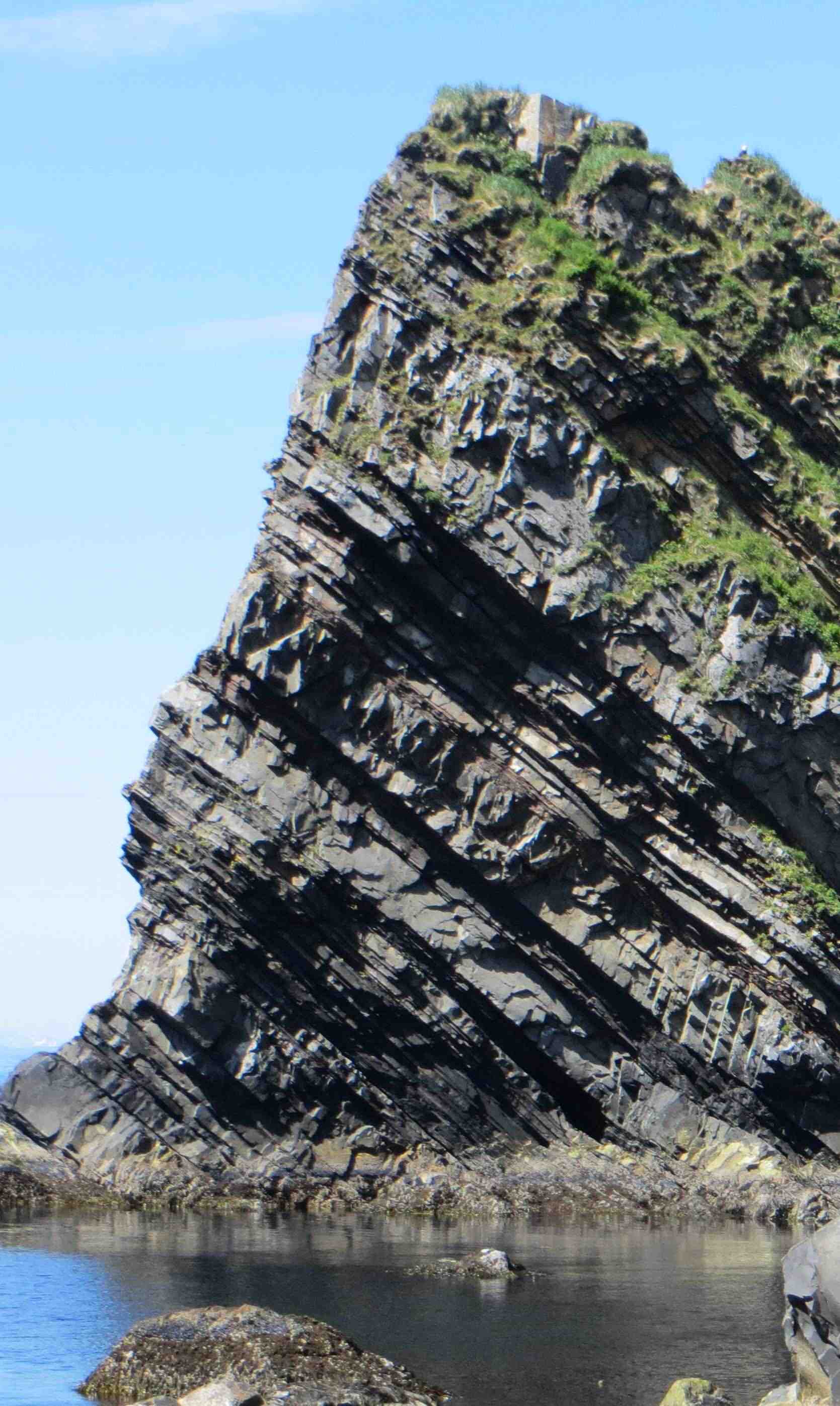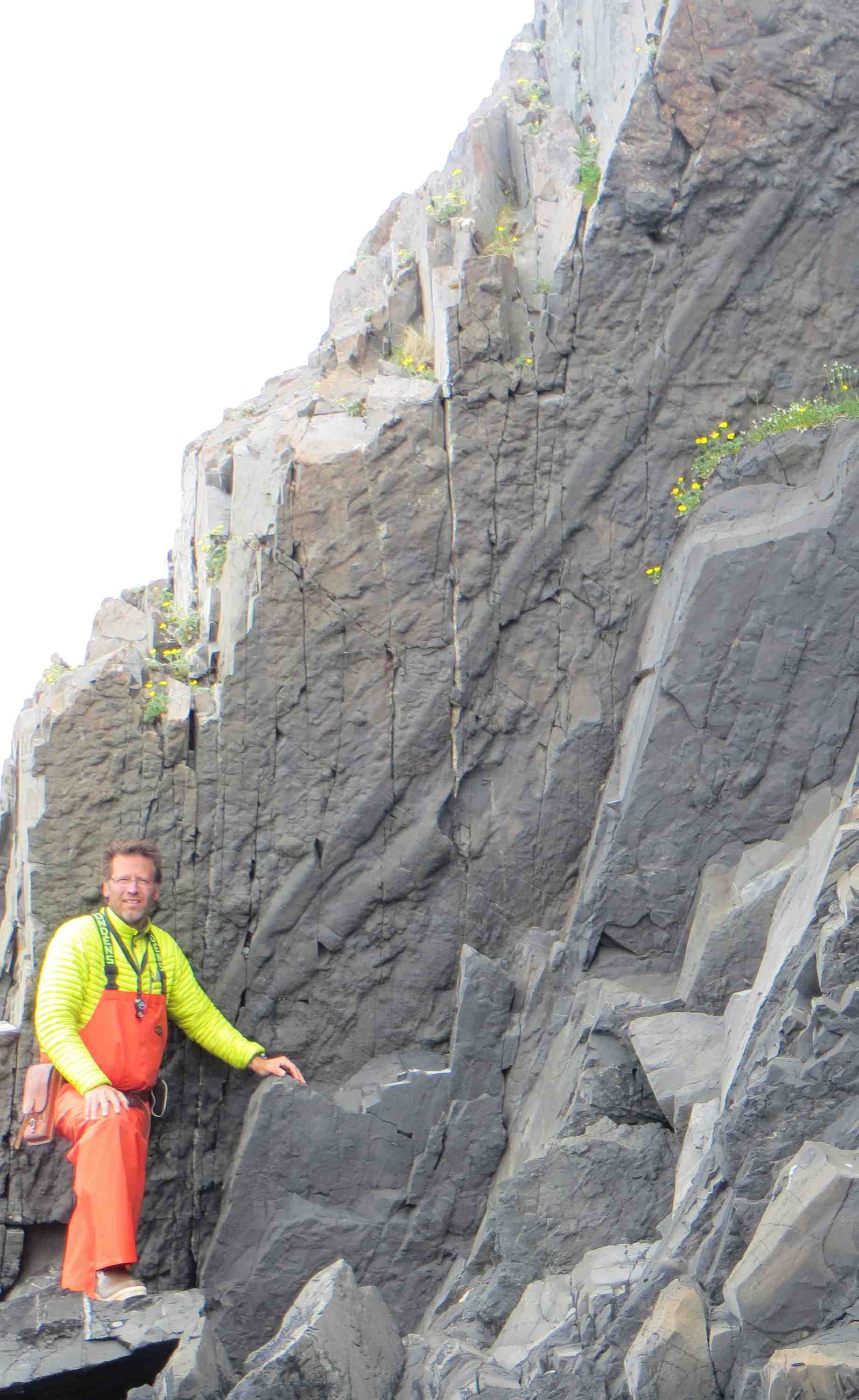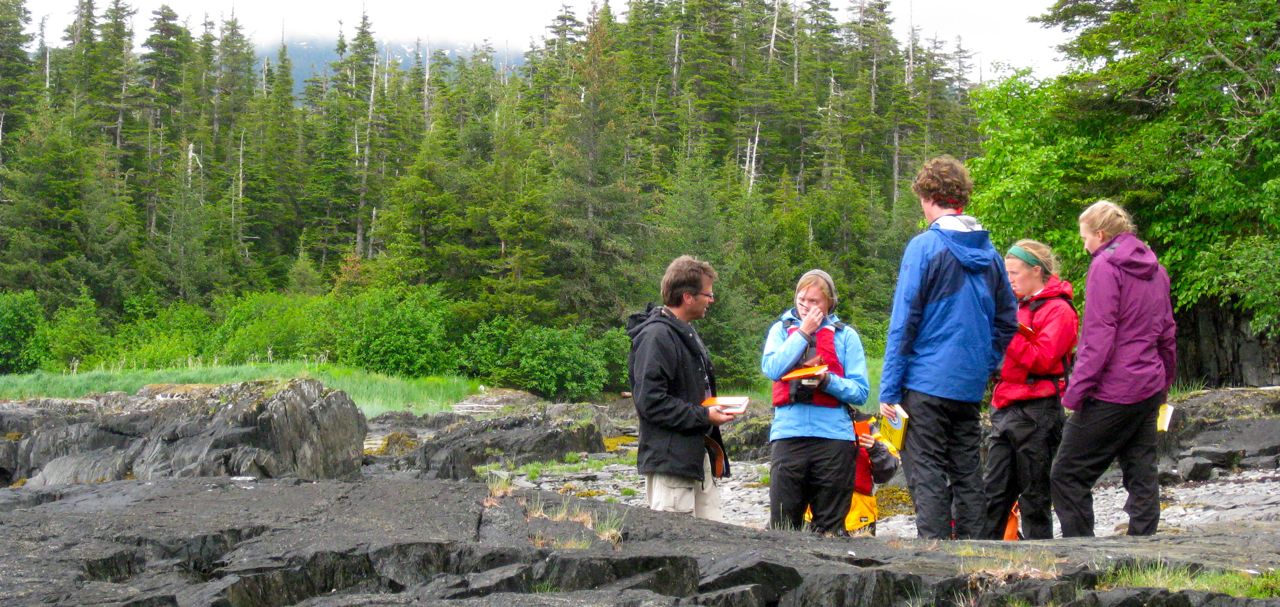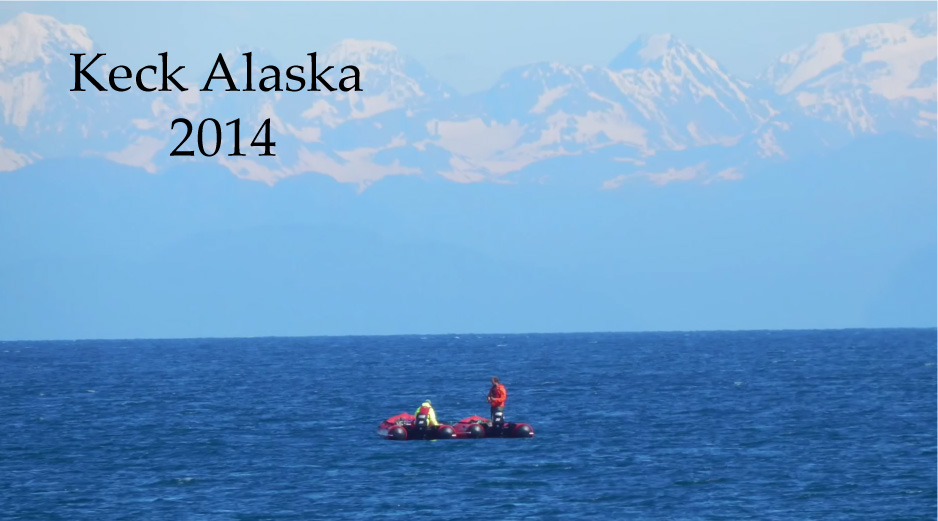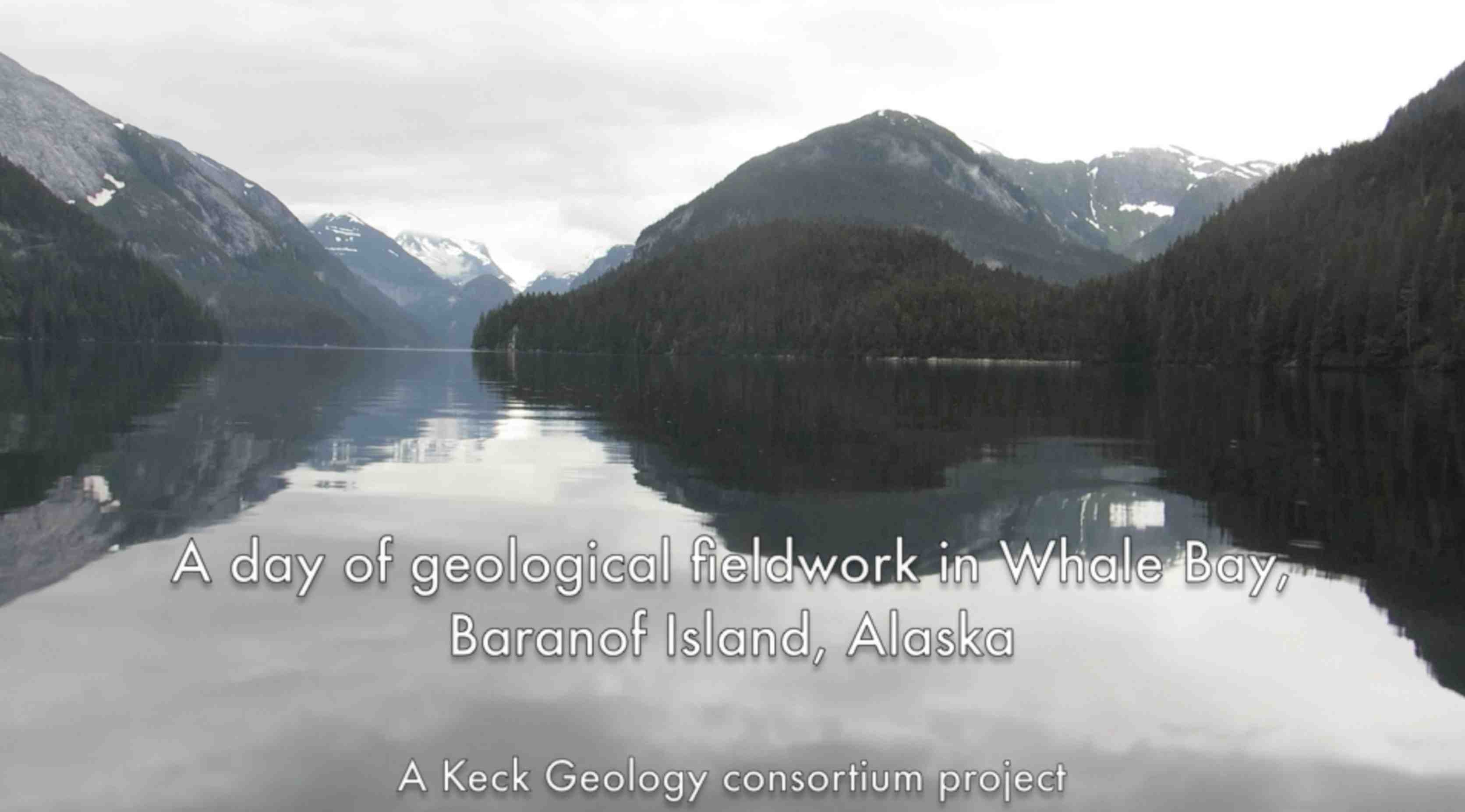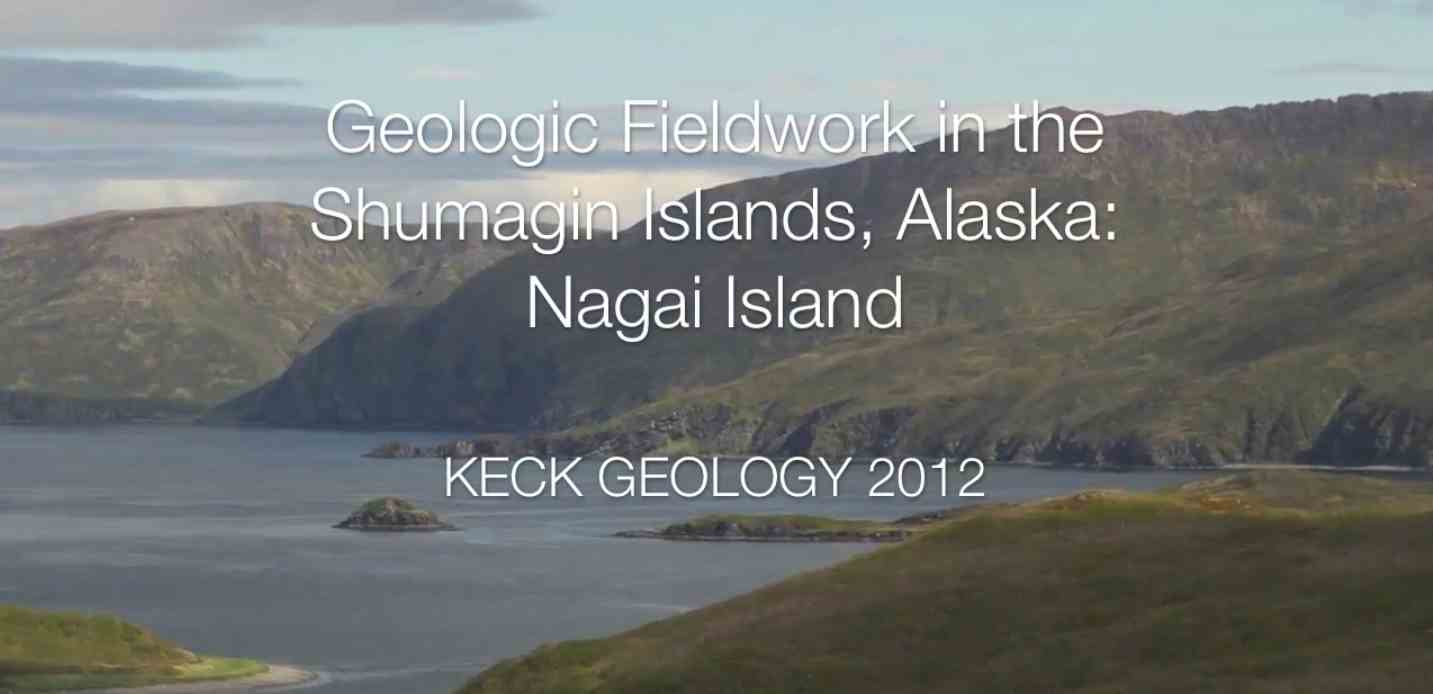Keck Alaska: Evolution of flysch of the
Chugach and Prince William Terranes, Alaska
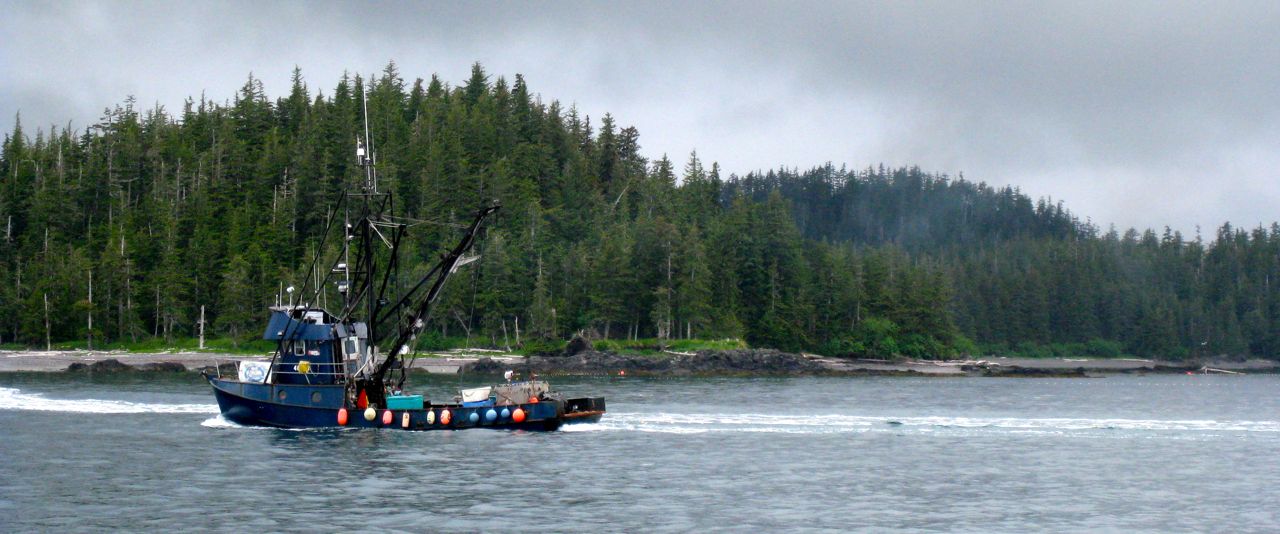
This NSF-funded research effort is focused on the provenance and thermal evolution of Campanian-Paleocene flysch of the Chugach-Prince William (CPW) terrane and post-accretion plutons in southern Alaska. This thick and extensive accretionary complex was intruded by near-trench plutons inferred to be related to an adjacent trench-ridge-trench triple junction, but the location of this terrane at the time of ridge interaction is under debate. There are two prevailing hypotheses for its position of formation along the Cordilleran margin: 1) The CPW formed more or less in place and ridge interaction was related to the now-subducted Resurrection plate, or 2) the CPW formed far to the south, was intruded by near-trench plutons near 48-49°N, and was subsequently translated along the continental margin to Alaska. The possible formation of the CPW far to the south and subsequent translation along the continental margin may have been a defining event in Cordilleran tectonics and makes testable predictions for the provenance and thermal evolution of these rocks. This multidisciplinary work has focused on determination of U/Pb and ZFT ages of detrital zircon to unravel the source region of this accretionary complex and subsequent thermal history. To target unique and age-distinctive rocks in potential source pathways, a small but highly significant population of Precambrian grains will be selectively targeted for provenance analysis. Using a newly developed technique of ZFT dating low-retentive zircon, radiation-damaged grains will reveal the low-temperature thermal history of the CPW following low-grade metamorphism (lower greenschist and prehnite-pumpellyite). Together, these data yield important constraints on the accretion and translation history of the CPW and has implications for the history of flanking basins such as the hydrocarbon-rich Cook Inlet basin.
Publications and Abstracts listed at the bottom of this web page.
Understanding deformation in the Orca Group turbidites, Eshamy Bay, western Prince William Sound (Photo: J.I. Garver, Union College)..
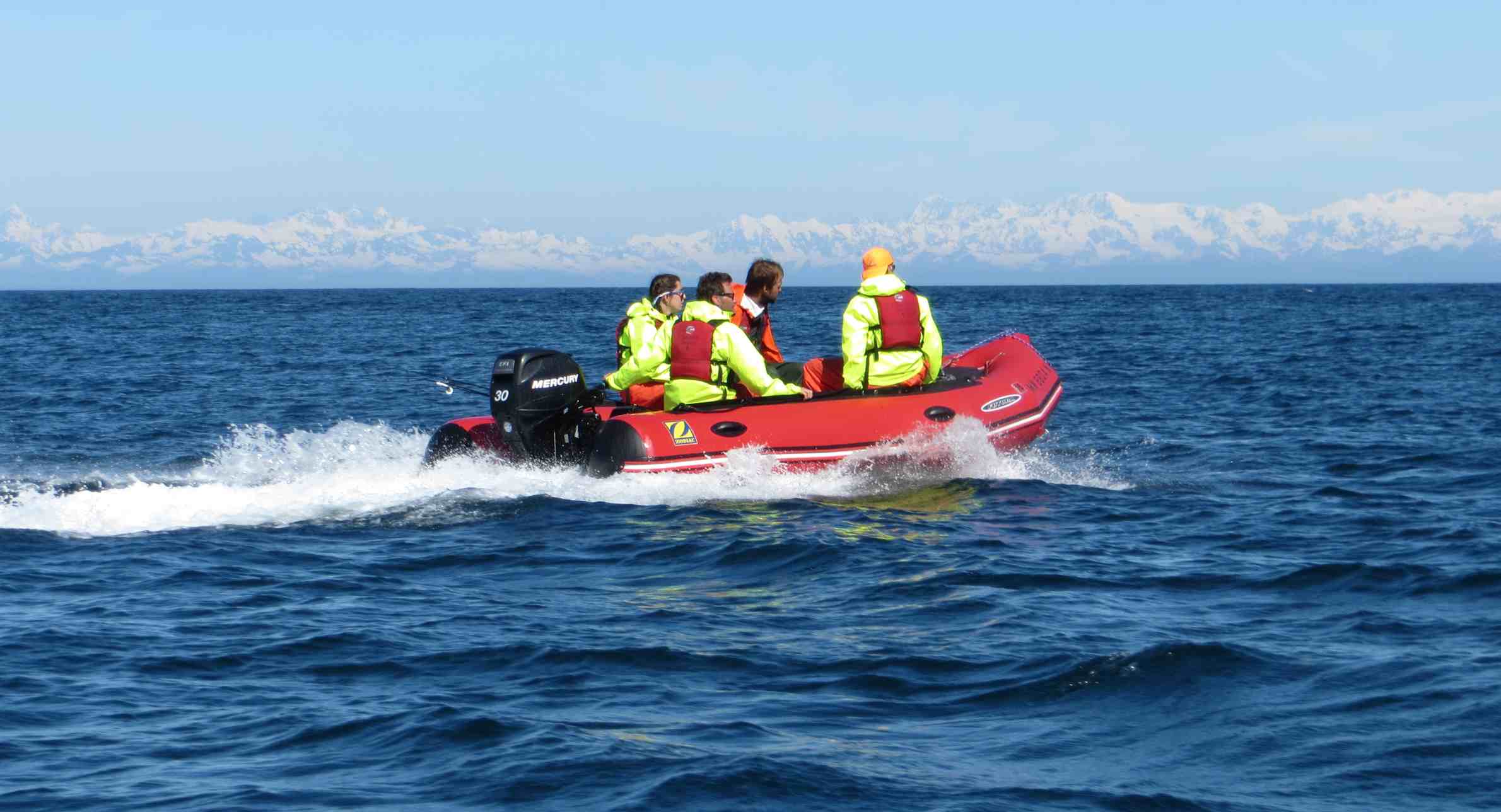
Sampling in Prince William Sound off Hitchinbrook Island.
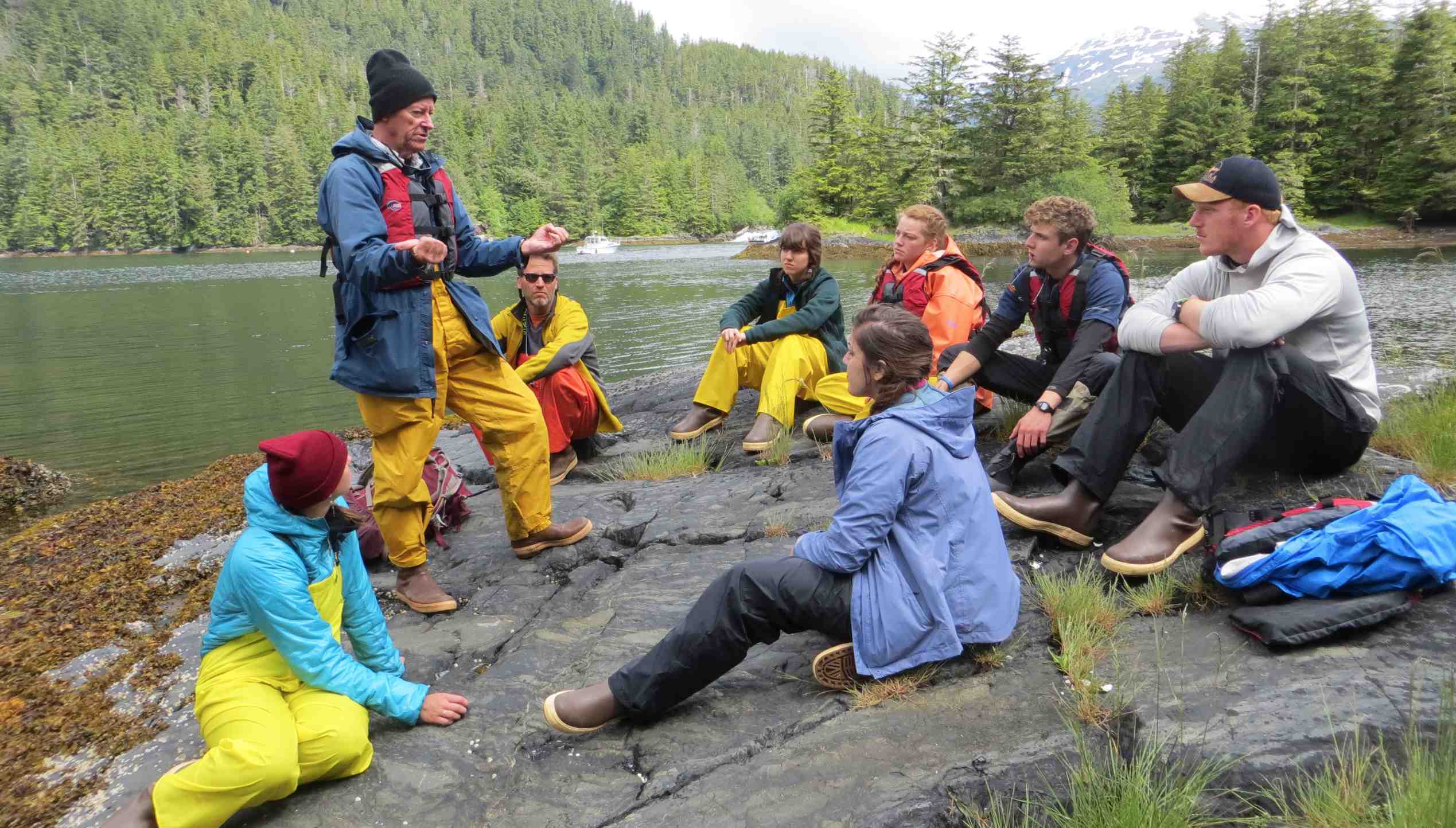
A review of layer-parallel extension and deformation in the Cretaceous Sitaka Graywacke, Redoubt Bay (Photo: J.I. Garver, Union College).
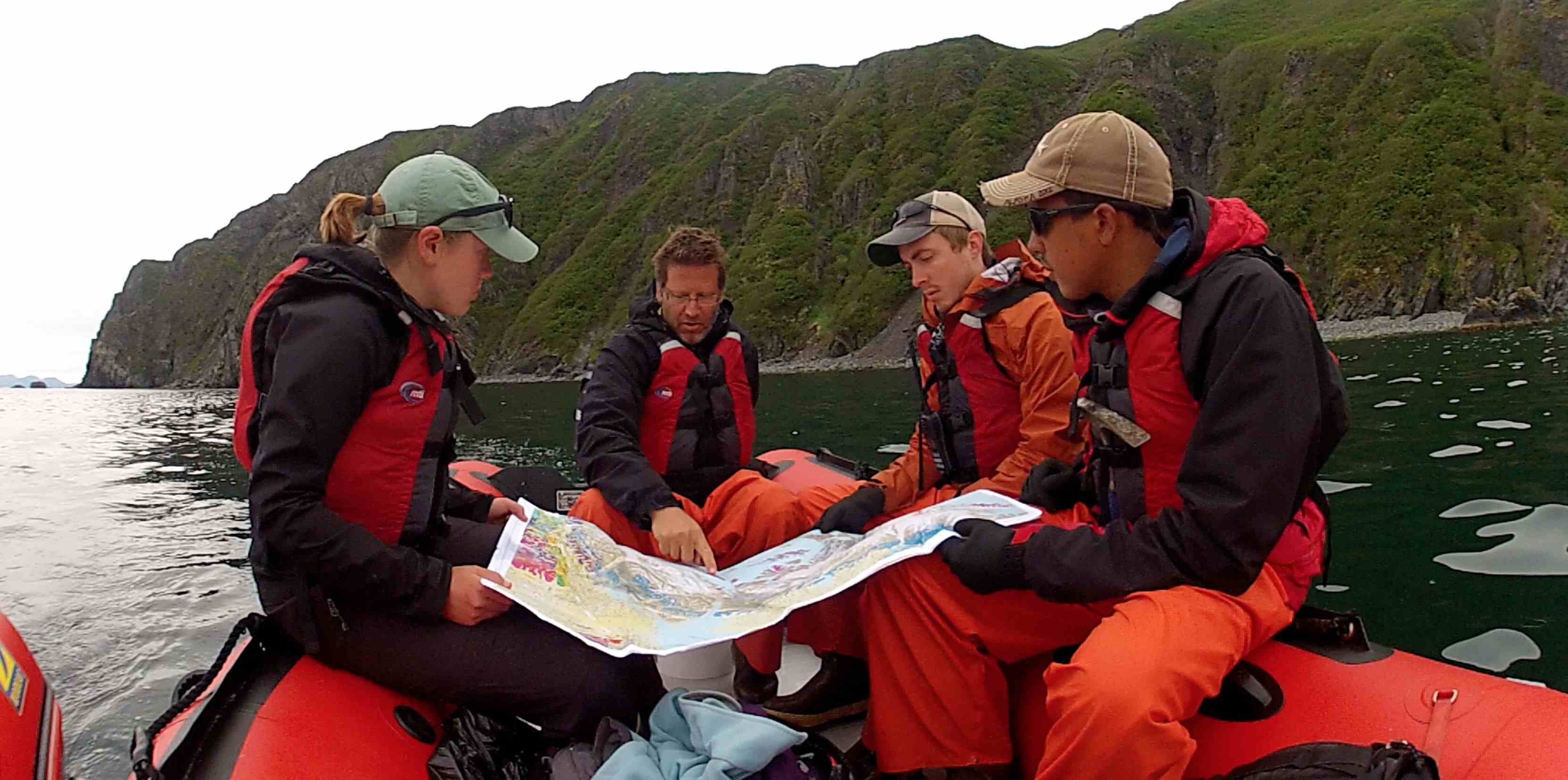
Designing a sampling strategy for the Cretaceous Shumagin Formation, Nagai Island (Photo: J.I. Garver, Union College).
Projects
2009-10 Project - Kootznahoo Formation and SE Alaska exhumation. This project set up ideas for the current and ongoing effort in the Chugach. This project started in Petersburg, Alaska, but all field work was out of Kake, Alaska, on the Northwest coast of Kupreanof Island.
2011-12 Project - Prince William Sound and Kodiak Island. This project was focused on rocks of the Orca Group in the Knight Island Passage area; and along-strike correlative rocks of the Ghost Rocks of Kodiak Island.
2012-13 Project - Kenai Peninsula and Shumagin Islands. This project was focused on rocks on the Kenai Peninsula in and around Seward and then on Nagi island in the Shumagin Islands.
2013-14 Project - Baranof Island, SE Alaska. This project is focused in the Sitka area and also slightly to the south in Whale Bay on Baranof Island.
2016-17 Project was focussed on the rocks in Yakutat Bay and Russell Fiord.
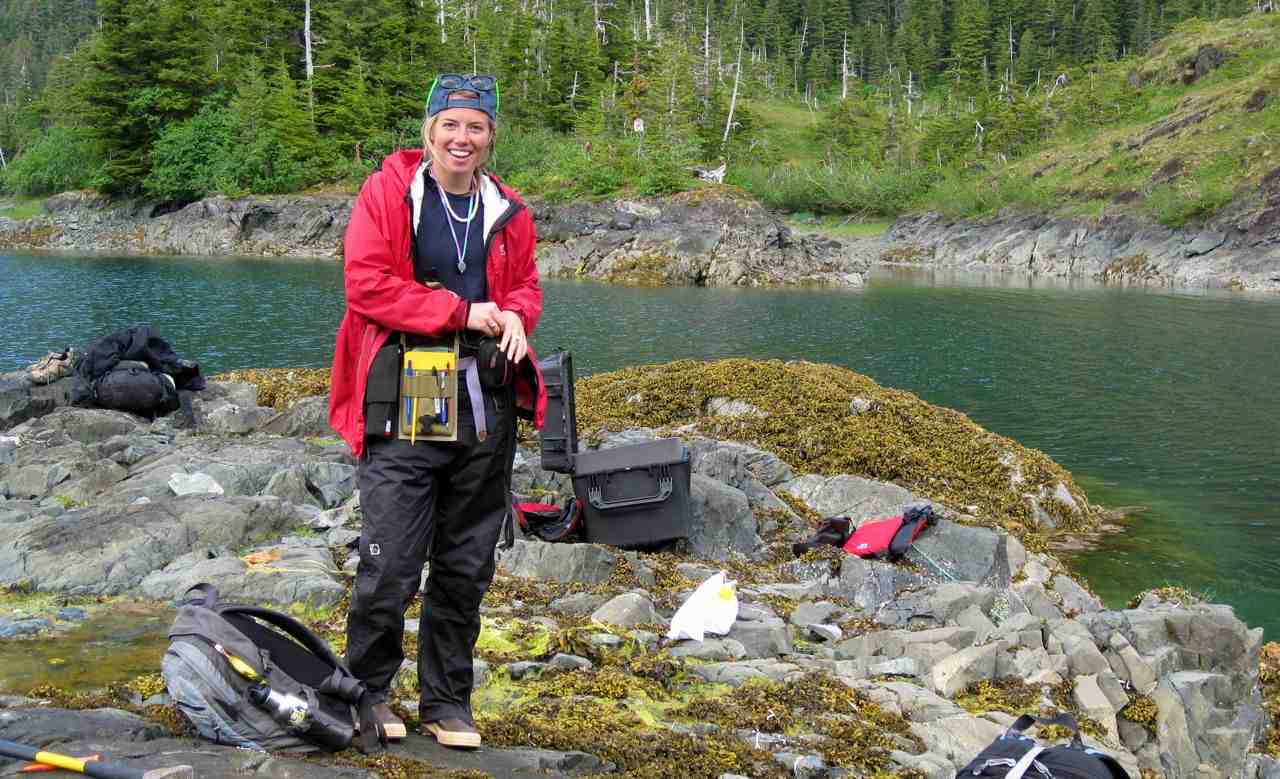
Field work on the Knight Island Ophiolite (here the sheeted dike complex) in Drier Bay, Prince William Sound (Photo: J.I. Garver, Union College)..
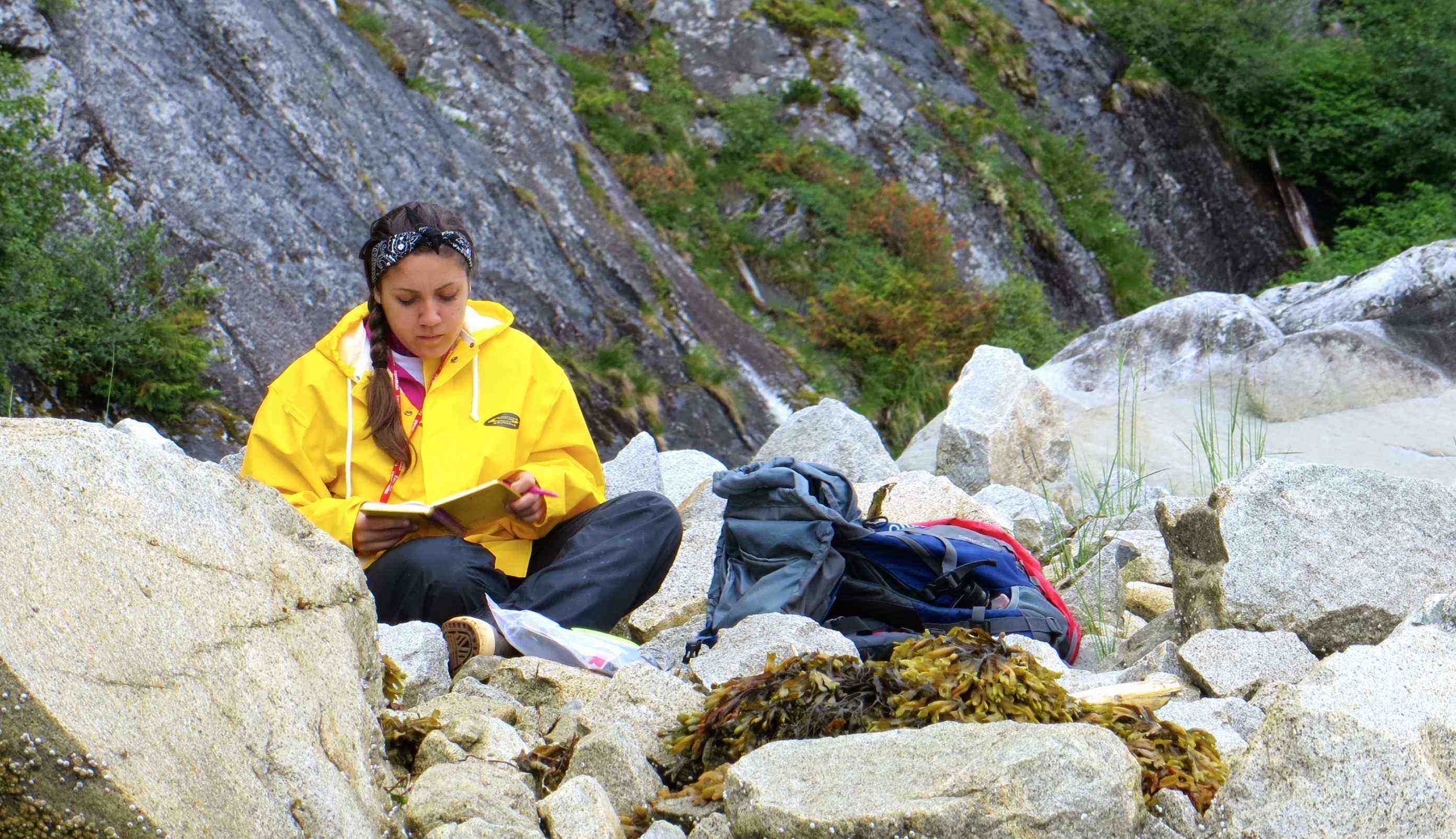
Field work on the Crawfish Inlet Pluton (50 Ma) in Whale Bay on Baranof Island (Photo: J.I. Garver, Union College).
PRIMARY FINDINGS
Our work has made significant progress toward understanding the age of sedimentary units, their thermal history, and the origin and source of igneous rocks. Our primary released findings to date include the following:
1) Age and provenance of the Paleocene to Eocene Orca Group. We determined the maximum depositional age of the Orca flysch along a transect in western Prince William Sound using U/Pb detrital zircon ages from ten locations (about 1500 zircons). The maximum depositional ages of flysch of the Orca Group ranges from 69 to 35 Ma, NW to SE, suggests that the bulk of the flysch (Valdez+Orca) of CPW terrane was more or less deposited continuously from ~85 Ma to ~35 Ma with only a few potential age gaps. Forty-two zircons from the preliminary data set are Precambrian, with modes at 1164, 1826, 1912, and 1988 Ma. A major finding from this work is that we can now divide the Paloecene-Eocene Orca Group into three distinct units or belts based on maximum depositional age (U/Pb) and thermal history.
The Orca Group consists of: [A] the inboard Whale Bay – Bainbridge Island Belt (Paleocene to earliest Eocene), which is in fault contact with the Valdez Group and has maximum depositional ages <57-58 Ma. This belt was accreted, intruded by, and regionally metamorphosed to greenshist grade by the 54 Ma SBB plutons and ~38 Ma Eshamy suite plutons (Johnson, 2011, see below); [B] the more outboard Latouche belt (Middle Eocene), which includes rocks on Evans and Latouche islands, has maximum depositional ages <38-40 Ma, and was intruded and metamorphosed to lower greenschist grade by ~38 Ma Eshamy suite plutons; and [C] the outboard Montague belt (Upper Eocene) deposited <35 Ma, and is essentially unmetamorphosed. The maximum depositional ages constrained by this study in combination with field observations suggest that the Orca Group was deposited contemporaneously with the intrusion of the flysch by near trench plutons of the Sanak Baranof Belt and Eshamy Suite plutons (see Johnson, 2011, below). The Latouche Belt must have been deposited, accreted, and intruded in a narrow window at 37-40 Ma (unresolvable within analytical uncertainty of U/Pb and ZFT). the detrital U-Pb data also support along-strike correlations between the Late Cretaceous to Eocene formations on Kodiak Island and those in Prince William Sound.
2) Age and provenance of clastic units on Kodiak Island. Our work involved analysis of six detrital zircon samples from a transect across the accretionary complex on Kodiak Island and reports on 782 single grain U/Pb ages. Samples from the Maastrictian Kodiak Formation, Paleocene Ghost Rocks Formation, Eocene Sitkalidak Formation, and the unconformably overlapping Miocene Narrow Cape Formation were analyzed. The Kodiak Formation is most distinctive because it has a relative abundance of Precambrian ages that primarily range from 1200 Ma to 2300 Ma. The abundance of Precambrian grains decreases sharply in younger more outboard units. The Ghost Rocks contains a much narrower spectrum of grain ages with the bulk at 66 ± 4 Ma and much fewer Precambrian grains (1038 to 1517 Ma). Based on maximum depositional ages, the U/Pb zircon data suggest that the Ghost Rocks in Ugak Bay are more closely allied with the Paleocene to earliest Eocene Orca Group (Whale Bay- Bainbridge Island belt from above) because the young U/Pb ages in Ghost Rocks (63 Ma) are younger than what has been recognized for the Valdez Group (68 Ma or older) and is statistically similar to the young ages in the older part of the Orca Group (61 to 68 Ma).
3) Thermal history of the CPW flysch in Prince William Sound. Zircon fission track (ZFT) dating has been used to work out the thermal history of the flysch along the same transect used by Hilbert-Wolf (2011, see link to PDF below). Almost all rocks of the CPW in Prince William Sound experienced greenschist to prehnite-pumpellyite grade metamorphism, and a major discovery from this work is that these rocks experience two thermal metamorphic events that ended at c. 50 Ma and c. 36-40 Ma, both coincident with the now well-dated plutonism (Johnson, 2011, see PDF below). The most outboard, and youngest accreted rocks of the Montague belt (<35 Ma, Hilbert-Wolf, 2011, see PDF below) are unmetamorphosed and preserve ZFT cooling ages from the source terranes of the flysch. In the rearward part of the wedge, rocks of the Valdez Group near Anchorage, show only minor heating and thermal resetting at c. 50 Ma; these new data suggest that at least locally rearward parts of the accretionary complex have resided relatively high in the crust following accretion. In eastern Prince William Sound, we have dated rocks along the Richardson Highway and around Cordova. In the Valdez Group, six samples from along the Richardson highway have FT grain ages much younger than inferred age of deposition: they have a common young cooling age of ~38 Ma and a memory of grains that are no younger than ~51 Ma, which likely contain partially annealed grains. Track lengths in the Valdez Group are bimodal in samples that have a significant population of partially annealed, retentive grains but unimodal in fully reset samples. In the more outboard Orca Group, the six samples (Sheep Bay to Cordova) have a common young cooling age of ~32 Ma and significant populations that are ~49 Ma and older. The ~52 Ma Sheep Bay granite has a ZFT cooling age of ~37 Ma. Ages and track-length distributions vary on either side of the NE-SW-trending Rude River fault.
4) Age of the Eshamy suite plutons in Prince William Sound. The age and origin of the Eshamy suite of granitoid plutons is now well established. New U/Pb zircon dates for five of the Eshamy suite plutons yield concordant dates between 37.6 ± 0.5 and 39.9 ± 0.7 Ma. We also report a 54.5 ± 1.8 Ma U/Pb zircon dates for the Sheep Bay pluton of the Sanak-Baranof belt from eastern Prince William Sound. The ~37-40 Ma Eshamy Suite intrusives corresponds to a short-lived intense thermal anomaly that is now well recognized in the ZFT cooling ages (Carlson, 2011, see PDF below). The major and trace element geochemistry of the Eshamy Bay and the Nellie Juan plutons show that these plutons: 1) do not have a strong MOR signature; 2) are not compositionally similar to synchronous adakites in the Caribou Creek Volcanic Field (CCVF) ~ 200 km north (Cole et al., 2006); 3) have a similar whole-rock geochemistry to sediments of the Orca Group; and 4) have trace element chemistry similar to synchronous rhyolites of the CCVF. These results support the correlation of the cogenetic relationship between the CCVF rhyolites and PWS plutons.
5) Knight Island ophiolite (KIO) in western Prince William Sound. Our results on the paleomagnetism and geochemistry of the Knight Island ophiolite, provide information about its origin. The Knight Island ophiolite, mapped as part of the Orca Group in Prince William Sound, is a spectacular sequence of sheeted dikes, pillow basalts, and interbedded clastic sediments that is likely a companion to the better studied ~57 Ma Resurrection Peninsula ophiolite (Nelson et al., 1987; Bradley et al., 2006 and references therein). Miner (2011, see PDF below) focused on the major and trace element geochemistry of the sheeted dikes and associated pillow basalts, as well as other basaltic rocks in the Orca Group on Chenega Island. Major element geochemistry from the KIO reinforces earlier speculations of the similarity between Knight Island and Resurrection Peninsula (cf. Lytwyn et al, 1997; Nelson and Nelson 1992). An interesting finding from this work suggests that the Chenega Island volcanics are distinct from those directly affiliated with Knight Island. Miner ( 2011, see PDF below) also shows that the Orca volcanic rocks (KIO and Chenega Island) are enriched in incompatible elements compared to N-MORB suggesting a contaminated mantle source. She uses a fractional crystallization and magma mixing model between the most primitive basalt compositions and the Orca flysch to help explain some of the compositional variation present in the trace element chemistry of the Orca volcanics. Espinoza (2011, see PDF below) reports preliminary paleomagnetic results from 83 cores collected at 11 sites from the Knight Island ophiolite and Eshamy suite plutons. The preliminary data confirms that samples from the sheeted dike complex appear to be affected by a strong thermal or chemical overprint identified in previous paleomagnetic studies on the pillow basalts from the northern part of Knight Island (Bol, 1993). This overprinting is likely related to the thermal events recorded in the ZFT results reported by Carlson (2011, see PDF below).
6) Age, provenance, and thermal history of the Shumagin Formation, Shumagin Islands. New detrital zircon U/Pb dates (n=1053) collected from ten samples of volcanic-lithic and arkosic sandstones from Nagai Island in the Shumagins confirm that the Shumagin Formation is Upper Cretaceous in age. The maximum depositional ages for ten samples are closely clustered and range from 73-77 Ma. The U/Pb zircon age of an interbedded tuff yields and age of 73.7 ± 1.2 Ma, further confirming the Late Cretaceous age of the Shumagin Formation and suggests that the ages of the youngest detrital zircons in most of the samples are close to the depositional age of these rocks. Collectively, samples from the Shumagin Formation have three main populations of zircon ages with modes at 74, 89, and 161 Ma with variation between samples mainly in the relative number of grains making up these populations. Only 17 out of 1053 grains are Precambrian. The Phanerozoic age populations match well with those from correlative rocks on Kodiak Island, Prince William Sound, and Yakutat suggesting a source region with an active Late Cretaceous arc built on a mostly Mesozoic age meta-plutonic basement Hf isotopic data on U/Pb-dated Phanerozoic grains show the Shumagin Formation zircons are dominated by positive εHf (t) values showing that the source is juvenile. Two new U/Pb dates from the Shumagin Batholith, part of the Sanak-Baranof Belt, are 61.7 ± 0.7 Ma and 62.6 ± 0.7 Ma, which we interpret as the crystallization age of these rocks. Detrital zircon fission track (ZFT) dates yield cooling ages of 58-44 Ma and appear to show variable amounts of overprinting related to intrusion of the Shumagin Batholith, and slab window heating associated with passage of the TRT triple junction. (Roe et al., 2013)
7) Age of Clastic Cover to the Resurrection Peninsula Ophiolite, Seward. Controversy surrounds the age of the ophiolites in the CPW in the Kenai/Prince William Sound area, and there is considerable disagreement about the age of strata in the Seward area. To determine the age, provenance and stratigraphic affinity of the clastic rocks interbedded with (and stratigraphically above) the Resurrection Peninsula Ophiolite, we collected U/Pb detrital zircon dates from four samples (n=404) from Thumb Cove, Humpy Cove, and Nash Road, across the bay from Seward. One sample (RB12-04), collected at the end of Humpy Cove, is from a thin-bedded, medium-grained sandstone interbedded with (and cross-cut by) basaltic rocks and thus this sample provides a key tie to the ophiolite. The maximum depositional age of this sample is 57 Ma given by a robust mode formed from the youngest four zircons. These clastic strata in Resurrection Bay are nearly idential in zircon grain age distribution to the Orca Group 70-80 km to the NE in Prince William Sound: 1) All samples from Resurrection Bay, and those of the Orca Group in western Prince William Sound (inboard of Montague Island), are dominated by a young population of grain ages between 57 and 75 Ma; 2) All samples have a minor fraction of grain ages dispersed between 100 - 225 Ma, and these grain ages occur in two primary populations. One between 100 - 115 Ma, and the other 155 - 225 Ma; 3) Comparing the Resurrection Bay samples directly to samples from different tectonostratigraphic belts in the Western PWS defined by Kveton (1989), they most closely resemble those of the Whale Bay Belt. A Kuiper's statistical test shows that the Resurrection Bay samples and Orca Group in the Whale Bay Belt, and correlative units along strike, are identical. Thus we conclude that the sandstones interbedded with the Resurrection Peninsula Ophiolite are stratigraphically correlative to the Orca Group. Because the clastic strata of the Orca Group are definitively tied to the ophiolite, these results breath new life into the paleomagnetic data obtained from the Resurrection Peninsula ophiolite that indicate a paleolatitude 13 ± 9° south of the present location to near present day northern Washington (Bol et al., 1992). Together, these results support large coast parallel transport of the CPW terrane since the Paleocene and the search for the original source of the clastic rocks may include terrains now far to the south. (Pettiette et al., 2013)
8) Variation of hafnium isotope composition of zircon in the CPW. Several hundred integrated U/Pb ages and Hf isotope compositions from four widely separated locations along the arcuate belt of the CPW reveal the age of basement crustal elements. In our data set U/Pb ages range from 34 Ma to 2935 Ma with εHf (t) values from +17.3 to -31.2; of the zircons we measured, about half are Precambrian, and about half are Phanerozoic. Zircons from the Shumagin Formation yield positive eHf (t) values consistent with partial melting of a relatively juvenile source region. This is in contrast to similar-aged zircons from the other three sampling areas (from west to east), Kodiak Island, Prince William Sound, and Yakutat, where eHf (t) values range from +11.9 to -26.5 suggesting that Phanerozoic zircons from these areas are crystalizing from melts derived from a heterogeneous source region that includes juvenile and Precambrian crust. Taken together, the integrated U/Pb and Hf isotope data show that the origin and provenance of detrital zircons from the CPW varies systematically along strike. Phanerozoic U/Pb ages have a strong Coast Mountains batholith signature with more juvenile crust in the magmatic source region in the Shumagin Formation, compared to tectonostratigraphically equivalent rocks in Kodiak, PWS, and Yakutat. (Roberts et al., 2013)
9) Zircon Crystallinity of detrital grains. To better understand the significance of single zircon grains, we used μ-Raman to measure single-grain disorder, and we use the position of the v3(SiO4) active mode (typically 1007 to 1008 cm–1) and measured uranium concentration to evaluate internal disorder in dated grains. We used μ-Raman to analyze 522 single grains, 165 of them Precambrian. The results indicate that there is a clear relationship between grain age and the position of the v3(SiO4) mode with a decrease in the v3(SiO4) mode with increasing age, which is generally consistent with increasing internal radiation damage with age. Precambrian grains fall into two distinct arrays of radiation damage: (1) grains of the Kodiak, Valdez, and Orca with considerable disorder; (2) Precambrian zircon of the Yakutat Group that have very little disorder. These data allow for refinement of specific source rocks that are viable candidates for clastic detritus in the CPW. (Garver et al., 2013)
10) Precambrian zircon from the CPW belt belong to two groups. One group has a wide range of grain ages characteristic of a northern Laurentian source (mainly those from Kodiak), and one group has a narrower range of grain ages that show a high degree of crystallinity and are likely from the SW US (see Garver et al., 2013 and Davidson et al., 2013). We recognized that Precambrian zircons from the CPW have different amounts of total radiation damage that can be related to metamorphic histories (Garver and Davidson, 2015), and our ongoing work has refined our understanding of the relationship between crystallinity and age by calibrating this empirically from zircons that are Devonian (Thurston et al., 2016) and Neoproterozoic (Garver and Davidson, 2016).
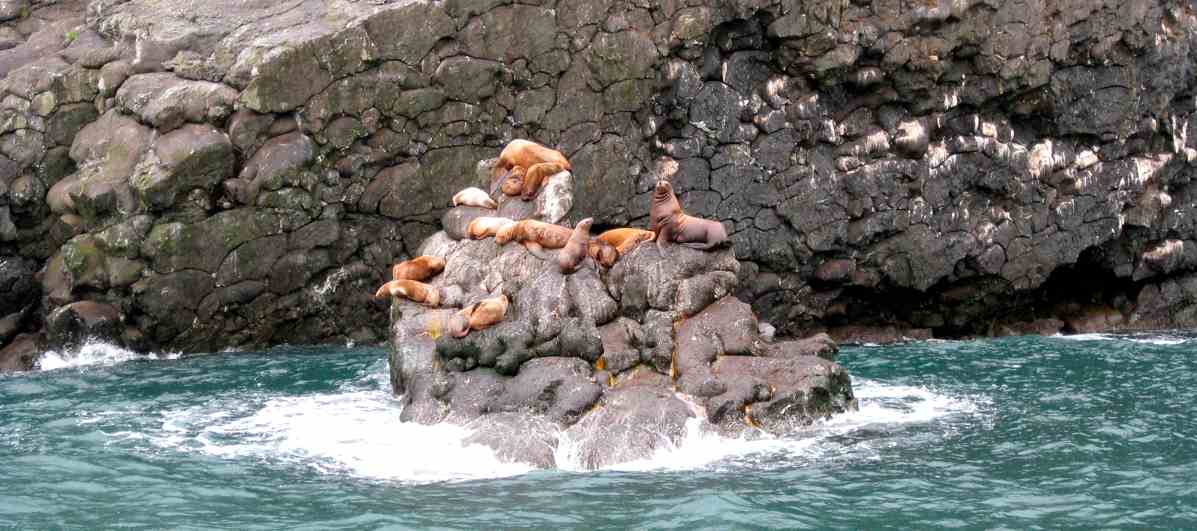
Sea lions on Pillow Basalts of the Paleocene Resurrection Peninsula Ophiolite, near Seward Alaska (Photo: J.I. Garver, Union College).
Publications on ALASKAN TECTONICS and this
research effort by this group
2017
Davidson, C., and Garver, JI, 2016. Evidence for rapid deposition, burial, pluton emplacement and metamorphism of the Chugach-Prince William terrane turbidites in eastern Prince William Sound, Alaska. Geological Society of America Abstracts with programs, Denver CO, v, 48, no 7.
Sophis, J.M., Garver, JI, Davidson, CM, Dolcimascolo, A, and Olson, H., 2017. Provenance and age distribution of detrital zircon in the Upper Cretaceous-Paleocene flysch and mélange of the Yakutat Group, Yakutat Bay and Russell Fjord, Alaska, Geological Society of America Abstracts with Programs. Vol. 49, No. 4, Honolulu, HI, doi: 10.1130/abs/2017CD-292959
Olson, H., Sophis, J., Davidson, C, and Garver, JI, 2017. Detrital zircon from the Yakutat terrane: differentiating the Yakutat Group and the Schist of Nunatak Fjord. Geological Society of America Abstracts with Programs. Vol. 49, No. 4, Honolulu, HI doi: 10.1130/abs/2017CD-292889
Dolcimascolo, A, Davidson, C, Garver, JI, Sophis, J., 2017. Provenance and age of Granitoid and sandstone clasts in conglomerates of the Paleocene to Upper Cretaceous Yakutat Group, Russell Fjord, Alaska. Geological Society of America Abstracts with Programs. Vol. 49, No. 4, Honolulu, HI doi: 10.1130/abs/2017CD-292921
Arntson, E, Olson, H, Davidson, CM, and Garver, JI, 2017. Geochemistry, U-Pb ages, and Hf isotopes of the Mt Draper and Mt Stamy Plutons, Nunatak Fjord, Alaska: Implications for the Sanak-Baranof Belt. Geological Society of America Abstracts with Programs. Vol. 49, No. 4 Honolulu, HI, doi: 10.1130/abs/2017CD-292866
Horst, A., Chapman, AD, Garver, JI, and Davidson, CM, 2017. U-Pb geochronology and Hf isotopic systematics of metamorphic and detrital zircon domains in the Schist of Sierra de Salinas, Central California Coast Ranges. Geological Society of America Abstracts with Programs. Vol. 49, No. 4, Honolulu, HI, doi: 10.1130/abs/2017CD-292976
Davidson, CM, and Garver, JI, 2017. Yavapai-Mazatzal detrital zircon ages in accreted rocks in southern Alaska: Looking for potential source rocks in the North American Cordillera. Geological Society of America Abstracts with Programs. Vol. 49, No. 4, Honolulu, HI doi: 10.1130/abs/2017CD-292979
2016
Garver, JI and Davidson, CM, 2016. Detrital zircon ages from conglomerate of the Douglas Islands, Narraguagus Bay Maine: A new recognized Neoproterozoic-Cambrian basement unit. Geological Society of America Abstracts with Programs. v. 48, No. 2.16
Enkelmann, E., and Garver, J. I. (2015). Low-temperature thermochronology applied to ancient settings. Journal of Geodynamics, Journal of Geodynamics 93 (2016): 17-30
Davidson, C., and Garver, JI, 2016. Evidence for rapid deposition, burial, pluton emplacement and metamorphism of the Chugach-Prince William terrane turbidites in eastern Prince William Sound, Alaska. Geological Society of America Abstracts with programs, v, 48, no 7. (Abstract).
Suarez, K, Garver, JI and Davidson, CM., 2015. Natural and laboratory examples of annealing radiation damage in zircon. Geological Society of America Abstracts with Programs. Vol. 47, No. 7, p.180 (Abstract)
2015
Wirth, KR, Greer, L, Garver, JI, Varga, RJ, Frey, HM, Peck, WH, Wobus, R, 2015, Keck Geology consortium research experiences: A model for mentoring student researchers and early career faculty, Geological Society of America Abstracts with Programs. Vol. 47, No. 7, p.622
Wirth, KR., Garver, JI, Greer, L, Pollock, M, Varga, R., Davidson, C, Frey, H. Hubbard, D., Peck, W., Wobus, R., 2015. Improving undergraduate research experiences with an intentional mentoring program: lessons learned though assessment of Keck Geology Consortium programs. AGU Annual meeting, Dec. 2015.
Lempert, R.N., Crowley, P.D., Davidson, C., Garver, J.I., 2015. Geochemical and petrologic evidence for magma mixing in the Sheep Bay and McKinley Peak Plutons, Prince William Sound, Alaska, Geological Society of America Abstracts with Programs. Vol. 47, No. 4, p.59. (Abstract)
Young, E.K., Fryer, K.H., Davidson, C., Garver, J.I., 2015. Tectonic evolution of the Chugach-Prince William terrane: geochemistry of the Orca Group volcanic rocks in eastern Prince William Sound, Alaska. Geological Society of America Abstracts with Programs. Vol. 47, No. 4, p.59 (Abstract)
Suarez, K, Garver, JI and Davidson, CM., 2015. Natural and laboratory examples of annealing radiation damage in zircon. Geological Society of America Abstracts with Programs. Vol. 47, No. 7, p.180
Schneider, E., Garver, J.I., and Davidson, C., 2015. Cooling history of the Sanak-Baranof plutons, Alaska, using Zircon and Apatite (U-Th_thermochronology. Geological Society of America Abstracts with Programs. Vol. 47, No. 4, p.58 (Abstract)
Molinek, F.R., Garver, J.I., and Davidson, C., 2015. Detrital zircon U/Pb ages and provenance of the Tofino Basin sedimentary sequence, Olympic Peninsula, Washington. Geological Society of America Abstracts with Programs. Vol. 47, No. 4, p.59. (Abstract)
Davidson, C. and Garver, J.I., 2015, New Insights into the Geology of the Chugach-Prince William terrane in the Seward area, Kenai Peninsula, Alaska: Field Trip Guide, Cordilleran Section of Geological Society of America, Anchorage, 29 p.
Davidson, C., and Garver, J.I., 2015, Tectonic evolution of the Prince William terrane in Resurrection Bay and eastern Prince William Sound, Alaska: Short Contributions, Keck Geology Consortium 28th Annual Symposium Volume, Union College, NY ( PDF )
Davidson, C., and Garver, J.I., 2015. Hf isotope signatures from Fore-arc plutons of the Sanak-Baranof belt, Alaska, suggest spatial and temporal control of crustal contamination. Geological Society of America Abstracts with Programs. Vol. 47, No. 4, p.59. (Abstract)
Garver, J.I., 2015. Detrital Zircon Thermochronology. in The Encyclopedia of Scientific Dating Methods, Edited by W.J Rink, and J.W. Thompson, Encyclopedia of Earth Sciences Series 2015, Springer, Dordrecht, Netherlands. p. 814-818
Enkelmann, E., Koons, P. O., Pavlis, T. L., Hallet, B., Barker, A., Elliott, J., .. & Van Avendonk, H. J. (2015). Cooperation among tectonic and surface processes in the St. Elias Range, Earth's highest coastal mountains. Geophysical Research Letters, 42(14), 5838-5846.
Enkelmann, E., and Garver, J. I. (2015). Low-temperature thermochronology applied to ancient settings. Journal of Geodynamics ( web link )
Alejos, E., 2015, Zircon fission track ages of the Orca Group on Hinchinbrook Island, Alaska: Short Contributions, Keck Geology Consortium 28th Annual Symposium Volume, Union College, NY ( PDF )
Suarez, K., 2015, Annealing radiation damage in Precambrian zircon in Whale Bay, Alaska and laboratory experiment: Short Contributions, Keck Geology Consortium 28th Annual Symposium Volume, Union College, NY (PDF)
Young, E., 2015, Tectonic evolution of the Chugach-Prince William terrane: geochemistry of the Orca Group volcanic rocks in eastern Prince William Sound, Alaska: Short Contributions, Keck Geology Consortium 28th Annual Symposium Volume, Union College, NY (PDF)
Lempert, R., 2015, Magma mixing over a slab window: geochemistry and petrology of the Sheep Bay and McKinley Peak plutons, Prince William Sound, Alaska: Short Contributions, Keck Geology Consortium 28th Annual Symposium Volume, Union College, NY ( PDF )
Grimm, B., 2015, Provenance of the Chugach-Prince William terrane, Alaska, focusing on the Paleogene Orca Group using U-Pb dating of detrital zircons: Short Contributions, Keck Geology Consortium 28th Annual Symposium Volume, Union College, NY ( PDF )
Molinek, F.R., 2015, Detrital zircon U/Pb ages and provenance study of the Paleocene to Miocene Tofino basin sedimentary sequence, Olympic Peninsula, Washington: Short Contributions, Keck Geology Consortium 28th Annual Symposium Volume, Union College, NY ( PDF )
Garver, J. I., & Davidson, C. M. (2015). Southwestern Laurentian zircons in Upper Cretaceous flysch of the Chugach-Prince William terrane in Alaska. American Journal of Science, 315(6), 537-556 ( PDF here).
Davidson, C. and Garver, J.I., 2015, New Insights into the Geology of the Chugach-Prince William terrane in the Seward area, Kenai Peninsula, Alaska: Field Trip Guide, Cordilleran Section of Geological Society of America, Anchorage, 29 p. (PDF of entire guidebook)
Garver, J.I., 2015. Detrital Zircon Thermochronology. The Encyclopedia of Scientific Dating Methods, Springer, Dordrecht, Netherlands,
Davidson, C., and Garver, J.I., 2015. Hf isotope signatures from Fore-arc plutons of the Sanak-Baranof belt, Alaska, suggest spatial and temporal control of crustal contamination. Geological Society of America Abstracts with Programs. Vol. 47, No. 4, p.59. (abstract)
Garver, J.I., and Davidson, C., 2015. Translation and Displacement of the Chugach-Prince William Accretionary Complex, Alaska. Geological Society of America Abstracts with Programs. Vol. 47, No. 4, p.51. (abstract)
Grimm, W., Alejos, E., Garver, J.I., and Davidson, C., 2015. Provenance and thermal history of the Paleogene Orca Group, eastern Prince William Sound, Alaska, using U-Pb and Fission track dating of detrital zircon. Geological Society of America Abstracts with Programs. Vol. 47, No. 4, p.59. (abstract)
Lempert, R.N., Crowley, P.D., Davidson, C., Garver, J.I., 2015. Geochemical and petrologic evidence for magma mixing in the Sheep Bay and McKinley Peak Plutons, Prince William Sound, Alaska, Geological Society of America Abstracts with Programs. Vol. 47, No. 4, p.59. (abstract)
Molinek, F.R., Garver, J.I., and Davidson, C., 2015. Detrital zircon U/Pb ages and provenance of the Tofino Basin sedimentary sequence, Olympic Peninsula, Washington. Geological Society of America Abstracts with Programs. Vol. 47, No. 4, p.59. (abstract)
Schneider, E., Garver, J.I., and Davidson, C., 2015. Cooling history of the Sanak-Baranof plutons, Alaska, using Zircon and Apatite (U-Th_thermochronology. Geological Society of America Abstracts with Programs. Vol. 47, No. 4, p.58. (abstract)
Young, E.K., Fryer, K.H., Davidson, C., Garver, J.I., 2015. Tectonic evolution of the Chugach-Prince William terrane: geochemistry of the Orca Group volcanic rocks in eastern Prince William Sound, Alaska. Geological Society of America Abstracts with Programs. Vol. 47, No. 4, p.59 (abstract)
2014
Garver, J.I., and Davidson, C.M, 2014. Detrital zircon of the Chugach-Prince William accretionary complex, Alaska, Geological Society of America Abstracts with Programs. Vol. 46, No. 6, p.444 (abstract here)
Brandon, M.T., Hourigan, J., Garver, J.I., 2014 New evidence for back arc basin interpretation from Eocene Coast-Range terrane, Geological Society of America Abstracts with Programs. Vol. 46, No. 6, p.657 (Abstract here)
Roig, CI, Cavosie, AJ, Davidson, CM, Garver, JI and Valley, JW 2014, Oxygen and hafnium isotope geochemistry of zircon, quartz, and garnet from the near trench Crawfish Inlet and Krestof plutons, Baranof Island, Alaska. Geological Society of America Abstracts with Programs. Vol. 46, No. 6, p.446 (Abstract here)
Roig, C.I., Cavosie, A.J., Davidson, C., Garver J.I., and Valley, J.W., 2014, Oxygen and hafnium isotope geochemistry of zircon, quartz, and garnet from the near-trench Crawfish Inlet and Krestof plutons, Baranof Island, Alasaka: Geological Society of America Abstracts with Programs. Vol. 46, No. 6, p. 446. (abstract)
Garver, J.I., and Davidson, C.M., 2014. Detrital zircon of the Chugach-Prince William accretionary complex, Alaska: Geological Society of America Abstracts with Programs. Vol. 46, No. 6, p. 444 (abstract)
Garver, J.I., 2014, Radiation-damage and cooling ages of Precambrian detrital zircon, Abstracts and Program, Thermo2014, Chamonix, France, Sept. 2014. Abstracts and Program, Thermo2014, Chaminox, France, Sept. 2014. (PDF of Abstract)
Frett, B.K., 2014, Detrital zircon U/Pb ages of the Paleocene Orca Group and Upper Cretaceous Valdez Group, Resurrection Bay, Alaska. Short Contributions, 27th Annual Symposium Volume, Mt Holyoke College, MA, p. 1-6. (PDF of paper)
Garver, J.I., and Davidson, C.M., 2014. Studies in Resurrection Bay and Baranof Island aimed at understanding the tectonic evolution of the Chugach-Prince William terrane, Alaska. Short Contributions, 27th Annual Symposium Volume, Mt Holyoke College, MA, p. 1-7.(PDF of paper)
Kaminski, K., 2014, Exhumation of the Baranof Schist, Alaska, determined though detrital zircon fission track dating. Short Contributions, 27th Annual Symposium Volume, Mt Holyoke College, MA, p. 1-7.(PDF of paper)
Rick, B.J., 2014, U/Pb dating of detrital zircons, Baranof Island, SE Alaska. Short Contributions, 27th Annual Symposium Volume, Mt Holyoke College, MA, p. 1-7.(PDF of paper)
Riehl, M.P., 2014. Thermal evolution of the Sitka Graywacke, Baranof Island, Alaska, revealed through zircon fission track dating. Short Contributions, 27th Annual Symposium Volume, Mt Holyoke College, MA, p. 1-6. (PDF of Paper)
Roig, C.I., 2014. Oxygen and Hafnium isotope geochemistry of zircon, quartz, and garnet from the Crawfish Inlet and Krestof Plutons, Baranof Island, Alaska. Short Contributions, 27th Annual Symposium Volume, Mt Holyoke College, MA, p. 1-6. (PDF of Paper)
Wackett, A.A., 2014. Petrography and geochemistry of the Crawfish Inlet and Krestof Island Pluton, Baranof Island, Alaska. Short Contributions, 27th Annual Symposium Volume, Mt Holyoke College, MA, p. 1-7.(PDF of paper)
Wackett, A.A., Smith, D.R., Roig, C.I., Cavosie, A.J., Davidson, C.M., Garver, J.I., Valley, J.W., 2014. Geochemistry and Geochronology of the Crawfish Inlet Pluton, Baranof Island, Alaska. Cordilleran Tectonics Workshop, University of British Columbia – Okanagon, Abstracts with program, p. 43-45. (PDF of abstract)
Rick, B.J., Frett, B.K., Davidson, C.M., and Garver, J.I., 2014. U/Pb dating of detrital zircon from Seward and Baranof Island provides depositional links across the Chugach-Prince William terrane and southeastern Alaska. Cordilleran Tectonics Workshop, University of British Columbia – Okanagon, Abstracts with program, p. 35-36. (PDF of abstract)
Kaminski1, K., Riehl, M., Garver, J.I., Davidson, C.M., 2014. Exhumation of the Chugach Prince William terrane, Baranof Island, SE Alaska. Cordilleran Tectonics Workshop, University of British Columbia – Okanagon, Abstracts with program, p. 27-28. (PDF of abstract)
Garver, J.I., Davidson, C.M., Frett, B.K., Kaminski, K., Rick, B.J., Riehl, M., Roig, C.I., Wackett, A.A., 2014. Tectonic evolution of the Chugach-Prince William terrane, Alaska: Constraints from Seward and Baranof Island. Cordilleran Tectonics Workshop, University of British Columbia – Okanagon, Abstracts with program, p. 17-19. (PDF of abstract)
2013
Davidson, C., and Garver, J.I., 2013. Tectonic evolution of the Chugach-Prince William terrane: Shumagin Islands and Kenai Peninsula. Short Contribution, Keck Geology Consortium, 26th Annual Symposium Volume, Pomona CA, p. 1-4.(PDF of paper)
Deluca, M., 2013. Thermal evolution and provenance revealed through detrtial zircon fisssion track dating of the Upper Cretaceous SHumagin Formation, Nagai Island Alaska. Short Contribution, Keck Geology Consortium, 26th Annual Symposium Volume, Pomona CA, p. 5-11.(PDF of paper)
Pettiette, R., Detrital zircon ages and provenance of cover strata to the Paleocene Resurrection Peninsula Ophiolite in Seward, Alaska. Short Contribution, Keck Geology Consortium, 26th Annual Symposium Volume, Pomona CA, p. 18-24. (PDF of paper).
Roberts, N., 2013. Along-strike variations of U/Pb and Hf isotope compositions in the Chugach-Prince William terrane, Southern Alaska. Short Contribution, Keck Geology Consortium, 26th Annual Symposium Volume, Pomona CA, p. 12-17. (PDF of paper).
Short, A.K., 2013. Age and Petrogenesis of the Shumagin Batholiths in western Chugach-Prince William terrane, Alaska. Short Contribution, Keck Geology Consortium, 26th Annual Symposium Volume, Pomona CA, p. 26-31 (PDF of paper).
Roe, C., 2013. Detrital U/Pb age determination: understanding the provenance of the Late Cretaceous Shumagin Formation, Alaska. Short Contribution, Keck Geology Consortium, 26th Annual Symposium Volume, Pomona CA, p. 32-37 (PDF of paper).
Garver, J.I., Davidson, C., Kaminski, K., Riehl, M., Suarez, K, 2013, Thermal evolution of source rocks of detrital Precambrian zircon revealed through integrated radiation damage, Chugach-Prince William terrane, Alaska, Geological Society of American Abstracts with Program, v. 45, n. 7, p. 221. (PDF of Abstract)
Davidson, C., Garver, J.I., Roberts, N.M., 2013, Hf isotope signature of detrital Precambrian zircon suggest a southern Laurentian Source for the Upper Cretaceous flysch of the Chugach-Prince William terrane, Alaska, Geological Society of American Abstracts with Program, v. 45, n. 7, p. 221. (PDF of Abstract)
Kaminski, K., and Suarez, K., 2013, Determining radiation damage through Raman spectroscopy analysis of detrital zircon grains in the Chugach-Prince William terrane, Alaska; 23nd Steinmetz Symposium, Union College, Schenectady NY. (PDF of Abstract).
DeLuca, M., 2013. Thermal Evolution and provenance revealed through detrtial zircon fission track dating of the Upper Cretaceous Shumagin Formation, Nagai Island, Alaska; 23nd Steinmetz Symposium, Union College, Schenectady NY. (PDF of Abstract).
Roe, C.F., Davidson, C.M., Garver, J.I., DeLuca, M.J., and Short, A.K., 2013. Provenance and thermal history of the Upper Cretaceous Shumagin Formation, Nagai Island, southern Alaska, 2013 Cordilleran tectonics workshop, Kingston Ontario, Abstracts with Program, p. 51-52. (PDF)
Roberts, N.M., Davidson, C.M., Garver, J.I., Hilbert-Wolf, H., 2013. Along-strike variation in detrital zircon hafnium isotopic compositions from the Chugach-Prince William terrane, Alaska. 2013 Cordilleran tectonics workshop, Kingston Ontario, Abstracts with Program, p. 50-51. (PDF)
Pettiette, R.A., Rahl, J.M., Davidson, C.M., Garver, J.I., 2013. Age and provenance of cover strata to the Paleocene Resurrection Peninsula Ophiolite, Seward, Alaska. 2013 Cordilleran tectonics workshop, Kingston Ontario, Abstracts with Program, p. 36-38. (PDF)
Garver, J.I., Davidson, C.M., DeLuca, M.J, Pettiette, R.A., Roe, C.F., and Hilbert-Wolf, H., 2013. Constraints of the original setting of the flysch of the Chugach and Prince William terranes in Alaska using detrital zircon. 2013 Cordilleran tectonics workshop, Kingston Ontario, Abstracts with Program, p. 21-23. (PDF)
2012
Garver, J.I., Davidson, C., Hilbert-Wolf, H., Carlson, B., 2012. Provenance and thermal evolution of Flysch of the Chugach-Prince William terrane, Alaska; Geological Society of America Abstracts with Programs, v. 44
Carlson, B.M, 2012, Cooling and provenance revealed through detrital zircon fission track dating of the Upper Cretaceous Valdez Group and Paleogene Orca Group in Western Prince William Sound, Alaska, Proceedings from the 25th Keck Geology Consortium Undergraduate Research Symposium, Amherst MA, p. 8-16. (PDF)
Garver, J.I., and Davidson, C., 2012, Terrane translation in the north Pacific prior to establishment of the Aleutian- Kamchatka arc: History of the Olutorsky (Kamchatka) and Chugach- Prince William terranes (Alaska); Cordilleran Tectonics Workshop 2012, Victoria British Columbia, Abstracts and program, p. 19.
Espinosa, S., 2012, Paleomagnetism of the Knight Island Ophiolite, Southern Alaska; Proceedings from the 25th Keck Geology Consortium Undergraduate Research Symposium, Amherst MA, p. 17-22 (PDF)
Garver, J.I., and Davidson, C., 2012, Tectonic evolution of the Chugach-Prince William terrane in Prince William Sound and Kodiak Island, Alaska, Proceedings from the 25th Keck Geology Consortium Undergraduate Research Symposium, Amherst, p.1-7 (PDF)
Garver, J.I., Davidson, C., Hilbert-Wolf, H., Carlson, B., 2012, Provenance and thermal evolution of Flysch of the Chugach-Prince William terrane, Alaska; Geological Society of America Abstracts with Programs, v. 44. (Link to Abstract)
Garver, J.I., Davidson, C., Izykowski, T.M., and Carlson, B., 2012, Thermal resetting of detrital zircon in the Chugach-Prince William terrane in Prince William Sound of Alaska (USA), 13th International Conference on Thermochronology, China University of Geosciences, Abstracts with program, p. 25.
Hilbert-Wolf, H.L., 2012, U/Pb detrital zircon provenance of the flysch of the Paleogene Orca Group, Chugach-Prince William terrane, Alaska; Proceedings from the 25th Keck Geology Consortium Undergraduate Research Symposium, Amherst MA, 23-32 (PDF)
Miner, L., 2012, Geochemical analysis of Eocene Orca Group volcanics, Paleocene Knight Island Ophiolite, and Chenega Island volcanics in Prince William Sound, Alaska; Proceedings from the 25th Keck Geology Consortium Undergraduate Research Symposium, Amherst MA, p. 40-49 (PDF)
Olivas, S., 2012, U/Pb detrital zircon study of the Upper Cretaceous to Miocene strata of Kodiak Island, Alaska; Proceedings from the 25th Keck Geology Consortium Undergraduate Research Symposium, Amherst MA, p. 48-53 (PDF)
Olivas, S.J., Davidson, C., Garver, J.I., Doser, D., Hilbert-Wolf, H.L., 2012, U/Pb detrital zircon study of the Upper Cretaceous to Eocene strata of Kodiak Island, Alaska" Geological Society of America Abstracts with Programs (Rocky Mountain section meeting, Albuquerque NM), v. 44. (Link to Abstract)
2011
Davidson, C., Garver, J.I., Hilbert-Wolf, H.L., and Carlson, B., 2011, Maximum depositional age of the Paleocene to Eocene Orca Flysch, Prince William Sound, Alaska; Geological Society of America Abstracts with Programs, v. 43, n. 5, p. 439. (Link to Abstract)
Garver, J.I., Davidson, C., Izykowski, T.M., Milde, E.R., 2011, Thermal evolution of flysch of the Chugach Prince William terranes, eastern Prince William Sound, Alaska, Geological Society of America Abstracts with Programs, v. 43, n. 5, p. 553. (Link to Abstract)
Davidson, C., Johnson, E., Nicolaysen, K.P., Garver, J.I., 2012, Age and origin of Eocene Plutons in western Prince William Sound, Alaska: Low pressure melting of the Chugach-Prince William accretionary complex; Geological Society of America Abstracts with Programs, v. 44. (Link to Abstract)
pre-2011
Enkelmann, E., Garver, J.I., and Pavlis, T.L., 2008, Rapid exhumation of ice-covered rocks of the Chugach-St. Elias Orogen, Southeast Alaska. Geology, v. 36, n.12, p. 915-918.(PDF)
Enkelmann, E., Zeitler, P.K., Garver, J.I., Pavlis, T.P. and Hooks, B.P., 2010, The thermochronological record of tectonic and surface process interaction at the Yakutat–North American collision zone in southeast Alaska; American Journal of Science, v. 310, p. 231-260. (PDF)
Izykowski, T.M., Milde, E.R., and Garver, J.I., 2011, Fission-track dating of reset detrital zircon from the Valdez Group (Thompson Pass) and Orca Group (Cordova): Implications for the thermal evolution of the Chugach-Prince William terrane, Alaska, Geological Society of America Abstracts with Programs, v. 43, n. 4, p. 81. (Link to Abstract)
Johnson, E, 2012, Origin of Late Eocene granitiods in western Prince William Sound, Alaska; Proceedings from the 25th Keck Geology Consortium Undergraduate Research Symposium, Amherst MA, p. 33-39 (PDF)
Carlson, B., 2012, Cooling and provenance revealed through detrital zircon fission track dating of the Upper Cretaceous Valdez grouo and the Paleogene Orca Group in western Prince William Sound, 22nd Steinmetz Symposium, Union College, Schenectady NY. (PDF of Abstract).
Kaminski, K., and Riehl, M., 2012, Raman spectroscopy applied to Zircon Dating of the Upper Cretaceous Chugach and lower Tertiary Prince William terranes in Alaska; 22nd Steinmetz Symposium, Union College, Schenectady NY. (PDF of Abstract).
Meigs, A., Johnston, S., Garver, J.I., and Spotila, J., 2008, Crustal-scale structural architecture, shortening, and exhumation of an active, eroding orogenic wedge (Chugach/St Elias Range, southern Alaska), Tectonics, v. 27, TC4003, 26 pp. (PDF)
Perry, S.E., Garver, J.I., and Ridgeway, K., 2009, Transport of the Yakutat Terrane, southern Alaska, evidence from sediment petrology and detrital zircon fission-track and U/Pb double dating. Journal of Geology. V. 117, n. 3. p. 156-173. (PDF)
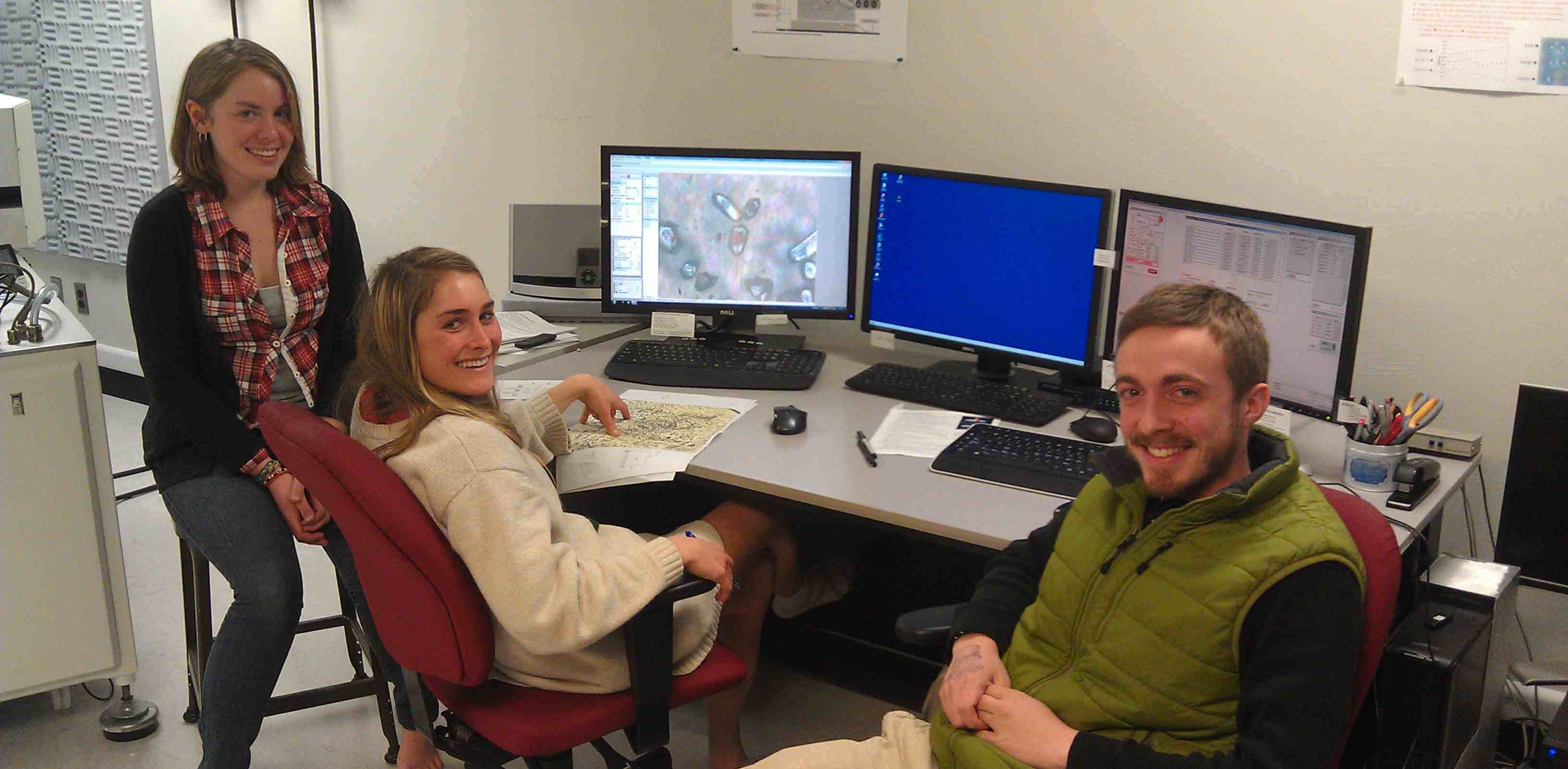
The 2012-13 team analyzes detrital zircon at the LaserChron Center at the University of Arizona (Photo C.M. Davidson, Carleton College).
Find Updates and photos from our latest efforts on the KECK ALASKA - FACEBOOK page.
See our video of Fieldwork in Prince William Sound in 2014 by Kaitlyn Suarez
See our VIDEO of FIELDWORK on Baranof Island in SE Alaska at Youtube.
See our VIDEO of FIELDWORK in the SHUMAGINS at Youtube.
FUNDING Provided by: NSF EAR 1116554 (to Garver, Union College) and EAR 1116536 (to Davidson, Carleton College): Collaborative Research: Provenance and Thermal Evolution of the Chugach-Prince William Terrane Flysch, Southern Alaska. EAR-1062720 (to Varga, Pomona College) "The Keck Geology Consortium--Providing Collaborative and Year-long Research Experiences for Undergraduates; Keck Geology Consortium project: Tectonic evolution of the Chugach-Prince William terrane, south-central Alaska. Project Directors: Cam Davidson (Carleton College) and Garver (Union College); NSF DMR 0959272 MRI-R2: Acquisition of Micro-Raman and Micro-IR Spectrometers for a Multi-disciplinary Spectroscopy Laboratory at Union College.

